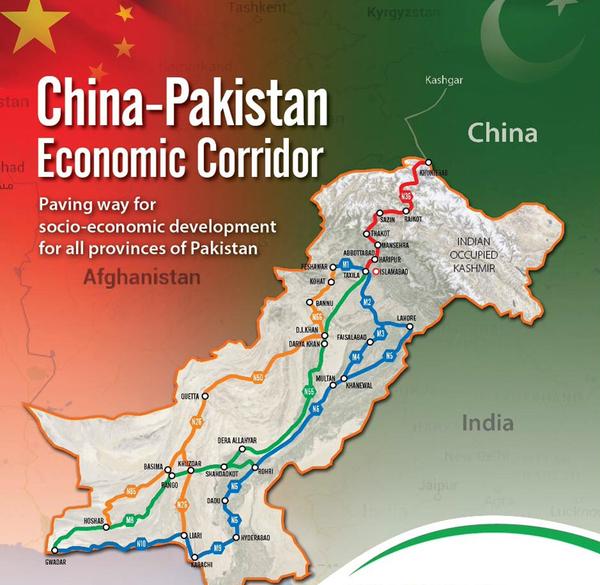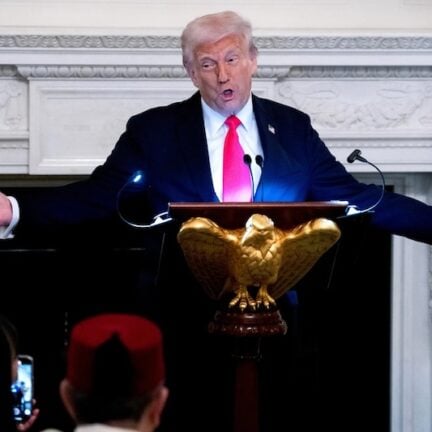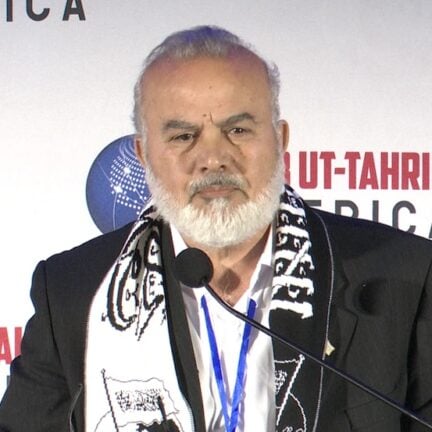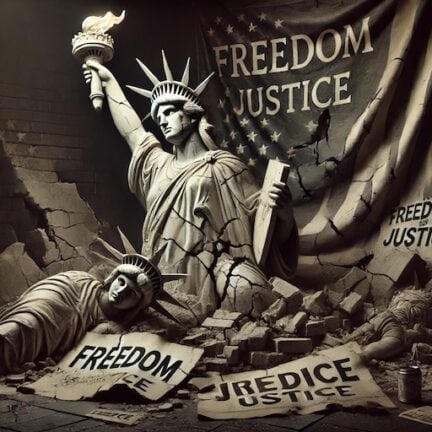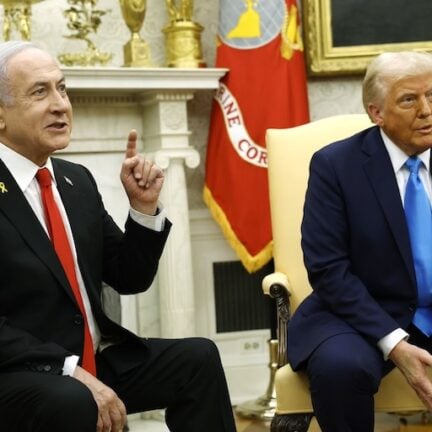Question: “Iran signed a trilateral agreement with India and Afghanistan for joint cooperation in the transit areas across the Chabahar port that overlooks the Omani Sea, South of Iran… The signing over this strategic agreement was completed that aims to establish an international transporting corridor for the three countries… Chabahar is about 100 km (60 miles) from Pakistan’s Gwadar seaport which China is developing as part of a $46 billion China-Pakistan Economic Corridor” (Al-Arabiya, 24/05/2016). Approximately a year ago on 20/04/2015, China and Pakistan agreed upon the launching of the economic corridor… The question here is: Are these projects merely huge economic projects or are they mixed with political motives?
Furthermore the states involved in these projects are tied to America with the exception of China, does this mean that behind these projects lies a scheme against China in order to preoccupy it far away from the South Chinese Sea and to economically exhaust it on the corridor due to its importance despite the economic returns are not equal to the $46 billion cost? Lastly, do the project objectives go beyond the signatory countries to other states like the states of Central Asia? Jazakallahu Khairan and I apologise for the lengthy question.
Answer
To answer this clearly we will present the following matters:
Firstly: America’s relationship with the participating states in the two projects mentioned in the question:
1 – When India’s loyalty became for America during the time of the BJP government that reached to power in 1998, then fell in 2004, and then returned once again to the rule 10 years later in 2014 under the leadership of Modi, at that time the American support became clear and apparent. Thus agreements between the two states in various sectors and particularly the nuclear field increased. It was clear that this was directed against China. As for Pakistan, its loyalty has remained as it has, loyal to America, since the era of the governments of Nawaz Sharif during the 1990’s passing the rule of Pervez Musharraf and then Asif Zardari until the current rule of Nawaz Sharif. Due to their joint loyalty to America there has been a rapprochement between India and Pakistan; and Pakistan made concessions in India’s favour in significant matters based upon American dictation in order to strengthen their agents in India and their position towards China. America had defined the role and task of Pakistan as being to fight against the Islamic movements internally and regionally. This is what has been called the war against terrorism and extremism. It was mentioned in the answer to question dated 09/06/2016: “Despite the fact that the regime in India is pro-America, as is the regime in Pakistan too, but the American goal for both countries is different, the goal for India is to form the spearhead in the face of China. As for Pakistan’s goal is to stand in the face of Pakistani and Afghan resistance that is anti-America…”
2 – In regards to Iran, it too is loyal to America and has admitted its cooperation with America in its occupation of Afghanistan, assisting it in bringing stability there, its support to agent governments subservient to America like the former Karzai government and the current government of Ashraf Ghani. Recently the Turkish World News reported on 29/06/2016, “The interview of the Iran Newspaper with Ali Akbar Velayati, former Iranian Foreign Minister who currently works at the head of advisors to the Supreme Guide of the Republic Ali Khamenei. In the interview he admitted the relationship and cooperation between Iran and America and said:
“Iran held talks with America about Afghanistan… And in those talks was our permanent representative in the UN and he is currently the Foreign Minister Mohammad Javad Zarif… And the greatest portion of Afghanistan was in the hands of the Taliban. And in those circumstances, had it not been for Iran, America would not have been able to enter Afghanistan…” He also said, “Similar to that happened in respect to the subject of Iraq where Iran and America made an agreement. Talks took place with the aim of participating in securing the security of Iraq after the fall of Saddam…”. Similar admissions were reported from Hashemi Rafsanjani, the former President of the Iranian republic and that all of that was by the permission of the authority, when he said: “The talks taking place now between America and Iran are based upon prior permission from the seat of the Supreme Guide. The negotiations had begun with America through Qaboos the Sultan of Oman before the coming of the Hasan Rouhani government by five or six months”…”. All, which confirms the Iranian-American relationship and that America, in return provided a role for Iran in Iraq and Afghanistan… It was mentioned in the answer to question dated 11/06/2014, “On the other hand, it appears that America is giving a role for India in Afghanistan and works to strengthen relations between the two countries so as not to remain in need of Pakistan to promote stability.
Hence, the first president that Modi met at his inauguration was Karzai of Afghanistan. Thus, America trusts India when the Government is loyal to it; as is the case now, more than its trust in Pakistan. Although the government in Pakistan is loyal to it, but is afraid that any change may happen in this Muslim country at any moment, so it is unsafe for it in the long run… Therefore, India in the era of the American loyal, Modi, will play an active role in terms of security in Afghanistan in favor of the American loyal regime there.”
And now the economic cooperation is added to that in order to strengthen and backup the security cooperation and protect the American interests in Afghanistan.
Secondly: The Iran India Afghanistan project (Transit aaccord):
1 – India and Iran discussed the idea of an Indian passage to Chabahar for the first time in 2003 when they agreed to joint development for the port. And in 2004 a coalition of Indian companies signed a memorandum of understanding (MoU) with the ports association and Iranian freighting to develop the installation. This however was not accomplished. However, in May 2015, two months before the complete joint action plan about the Iranian nuclear programme, Indian Transportation Minister, Nitin Gadkari, visited Iran to sign a MoU about Chabahar. Immediately afterwards the representatives of Iran, Afghanistan and India met in New Delhi to complete the draft Chabahar agreement. The signing between those three was completed on 23/05/2016 and that is to develop the port of Chabahar in the far east of Iran and to transform it into a trade corridor upon the Indian Ocean with the objective of increasing the trade exchange between the trilateral states. This came following the lifting of sanctions upon Iran as a result of the signing of the nuclear programme accord. The Indian Prime Minister Modi said in Tehran: “We want to link to the world, but connectivity among ourselves is also a priority,” he said. “The corridor would spur unhindered flow of commerce throughout the region. Inflow of capital and technology could lead to new industrial infrastructure in Chabahar.” He said as he pledged 500 million dollars, “This is a corridor of peace and prosperity,” Modi said of the trilateral deal in a tweet. “It will positively impact the lives of people and deepen economic ties.” And the Iranian President Rouhani said: “The agreement is not merely an economic document but a political and regional one… Today’s agreement will not be against any country and the activities of the three countries will be to the interest of the whole region.” He cautioned that the agreement was not against any other country, but to the benefit of “peace and stability in the region”.” Twelve memorandums of understanding were signed with Modi obliging India to pay $6.5 billion to Tehran which it had not been able to recover due to the international sanctions” (AFP 25/05/2016). The AFP agency additionally commented saying: “A seaport is being made available to Afghanistan because it does not overlook the sea and it includes the development of a rail track and route across Iran to Afghanistan. And it reflects a strategic victory for India against China. India wants to compete with China that is investing in the port of Gwadar which is 100 km away from Chabahar”. This is then clear in the explicit expression of the Iranian President in respect to these projects not being economic alone but rather political and that they have a relationship with the regional situation in the neighbouring China region. Even if the Iranian President said that this is not directed towards anyone, it nevertheless in its face value and understanding indicates that it is directed against someone! The Iranian president affirmed that it is not only economic but also political and regional. That is whilst the Indian Prime Minister pointed to the priority of strengthening the connection between the three countries, meaning strengthening the relations between them and that is for their trilateral objectives.
2 – It was announced that from these Indian-Iranian projects a gateway to the Central Asian republics was intended. The Iranian foreign minister Javad Zarif called to “speeding up the implementation of the strategic project between the Iranian Islamic Republic and India of Chabahar’s development due to its role in strengthening the rail, land and trade transport routes crossing between the Central Asian region and China” (Iranian Aalam site, 17/04/2016). Similarly, according to the Indian Ministry for Foreign Affairs, the agreement “will improve, in a noticeable manner, the use of the Chabahar port to assist in Afghanistan’s economic development and prepare a better regional connection, including India and connections with Afghanistan and Central Asia” (The Diplomat, 18th April 2016). And this is clear in the Iranian president Hasan Rouhani’s statement in a press conference on the 24th May 2016 when he said: “With our joint investments in Chabahar we can connect India, through an assured route, with Afghanistan and the countries of Central Asia” (Quartz India, 24th May 2016). “The Indian government finally ratified the project for investment in the Chabahar port with $100 million” (Iranian Aalam page, 02/06/2016). And it mentions that the Chabahar port has a strategic location upon the Omani Sea and Indian Ocean and that it is the easiest of the routes leading to Central Asia and Afghanistan.
Thirdly: The Chinese-Pakistani project:
1 – Chinese President Xi Jinping visited Pakistan on 20/04/2015 (Reuters) and signed project agreements worth $46 billion with it including a network of routes of about 3000 km between Gwadar in Pakistan to the Xinxiang province (East Turkestan) in East China, in addition to a rail line, extension of pipe lines. The projects will provide China with an entry point to the Indian Ocean and what lies beyond it. “Pakistan, for China, is now of pivotal importance. This has to succeed and be seen to succeed,” Reuters quoted Mushahid Hussain Sayed, chairman of the Pakistani parliament’s defence committee, as saying. And the correspondents said: “This represents a great advancement in respect to Chinese ambitions to strengthen its economic influence in Central Asia and its south and this exceeds what the United States is spending in Pakistan”. And at that time Ihsan Iqbal, the Pakistani minister responsible for the plan, told AFP, “These are very substantial and tangible projects which will have a significant transformative effect on Pakistan’s economy.” The Chinese President said to Pakistani media, “China and Pakistan need to align security concerns more closely to strengthen security cooperation.” 50 agreements were signed in relation to Chinese investments in Pakistan, 30 of which were agreements related to the economic corridor.
Nawaz Sharif said: “Xi’s visit to Pakistan represents a turning point in the history of relations between the two countries and the Pakistan-China friendship is the cornerstone of Pakistan’s foreign policy, and the Pakistani people treasure the brotherly relationship with China.” Pakistan President Mamnoon Hussain said: “Nearly 3 billion people will benefit from the project. Pakistan has granted China the exclusive rights to utilise the Gwadar port for the next 40 years”. A new army division has been set up of 13,000 for new forces to protect the developing economic corridor. And China is providing secret nuclear and missile assistance to Pakistan in addition to Ballistic missiles that have nuclear capability and a range of 2750km.
Pakistani Prime Minister Nawaz Sharif said recently that he: “Is personally honoured in respect to the Chinese economic corridor that has the capability to change the fortune of millions of the region’s populations. And that the economic corridor will connect the whole region across a quick network of routes and rail line…” (Official Pakistan News agency, 12/07/2016).
2 – This economic action draws China into involvement with its relationship with Pakistan in the case where the latter shows them enthusiasm and works to entice China with these economic projects and ventures so that it spends huge amounts of money on them and is distracted in this direction. In that way Pakistan is providing a service to its master America which works to contain China and put it under a siege so as to prevent it from competing with it. It works to occupy it as far as possible from dominance over the South Chinese Sea. This matter is important for America since it expends its effort to obstruct Chinese attempts to gain control over the South Chinese Sea where China is expanding the Islands and building airports and ports upon them and then their control over the chain of Islands would come naturally when the Islands become subservient to it, taking into account that the Island chain stretches to encompass close to 250 islands. America wishes to turn the Chinese focus away to become preoccupied with projects that entice her so that it sees that they are more beneficial to it than Islands that hold no value for it! As such the Pakistani projects with China directed to the Pakistani Gwadar port are in opposition to the Indian-Iranian-Afghani projects directed to the Indian Baharata port whilst the two ports are close to each other with a distance of 60 miles between them. This matter will bring about China’s preoccupation within this region… And it is well known that the Gwadar port in Pakistan and the Chabahar port in Iran have geographical strategic and geo-political significance in the region. Likewise, each of them has an importance in respect to international maritime transportation and the oil trade… South Asian expert, Adam V Larkey, highlighted the political nature of the mentioned projects deal saying: “The massive Gwadar project reveals China’s regional power play. There is no comparison in scale and intent between China’s role in Gwadar and India’s in Chabahar, but the Americans are pleased that India is pushing back against the Chinese expansionist mindset” (The US supports the Chabahar deal between India and Iran, because it encircles (contains) the Gwadar project between China and Pakistan (Firstpost.com, 26th May 2016). By this manner, America wants to influence China via this project with Pakistan. That is because if the Chinese-Pakistani economic corridor project, that costs $46 billion, is finished, then that will then be like the heart of China, meaning that it will never abandon this project easily and thus be preoccupied with it away from other regions which are more important like the South Chinese Sea.
America is also inciting the countries of the region against China including the Philippines which went to the international court where the court ruled in the favour of the Philippines over disputed islands with China. The permanent international tribunal of arbitration in The Hague, The Netherlands, issued the decision on 12/07/2016 in which it announced that: ““The tribunal concluded that there was no legal basis for China to claim historic rights to resources within the sea areas falling within the ‘nine-dash line’” which China relied upon in its demand. And that: “The tribunal found that China had violated the Philippines’ sovereign rights in its exclusive economic zone by interfering with Philippine fishing and petroleum exploration, constructing artificial islands and failing to prevent Chinese fishermen from fishing in the zone”. China then rushed immediately at the time of the decision, over its official news service (Xinhua), to “confirm that China does not accept or acknowledge the decision of the tribunal” and its foreign office announced after that “That this ruling is null and void and does not have any binding force”. Indeed, it said: “The aim is dirty and it is not a solution to the dispute with China, or preservation of peace and stability in the South China Sea”. Then its President Xi Jinping announced that “China opposes and will never accept any claim or action based on these awards”. America then stood up and announced its support for the court’s decision and considered it as mentioned upon the tongue of its official State Department spokesman John Kerry as being “Final and legally binding on both China and the Philippines…and it represents a major contribution in the joint goal of reaching a peaceful solution to the disputes in the South China sea”. And called: “All parties to commit to the decision and refrain from making provocative statements or undertaking provocative actions (DBA, AFP, 12/07/2016).
Fourthly: Based on the aforementioned answers to the issues raised in the question are as follows:
A – The economic actions (or activities) that have taken place amongst the countries of the region, between India, Iran and Afghanistan, and between Pakistan and China are not purely economic but rather have political goals, and particularly as all of these states with the exception of China follow American policy.
B – America has provided India with a role to confront China. So just as it acted to strengthen its nuclear capabilities it also works to strengthen it economically, so that it is enabled and capable of playing this role, whilst it links it to Iran and opens up the room for investment there. It also works to strengthen the Iranian economy so that it does not collapse and remains playing or undertaking the role that has been provided to it by the region. America had already provided a role to India in Afghanistan to protect the American interests within it just as Iran supports the American interests in Afghanistan. For that reason, India and Iran moved to support the economy of Afghanistan, that is occupied by America, and opened the path before it to reach the port upon the sea.
C – America encourages Pakistan to strengthen its relationships with China so that it can entice it with projects that divert it from being preoccupied with expanding its actions to control the South China Sea. That is whilst at the same time it incites or stirs the states of the basin against China and creates problems and difficulties. The latest of which was the issuing of the decision from the international tribune of arbitration in The Hague, The Netherlands.
D – America targets the Central Asia region as it works to attract it to work with Pakistan and generates interests for it through reaching the port upon the sea across the economic corridor that China is building. In that way America is able to tie and bind the rulers of the region to interests alongside its agent Pakistan and then be enabled through connecting with them to control their relationships with Pakistan, and with the presence of interests for them there, so that the process of buying takes place… That is from one angle, and from another, then the goals of the trilateral project (Iran, India and Afghanistan) is also to reach Central Asia as was mentioned in the statements of Iranian and Indian officials and reaching Central Asia through the action of these states which are all loyal to America, without doubt represents a service to the American interests. In that way its influence is concentrated in the region in which the Russian influence is active.
Fifthly: In conclusion, this region had been under the rule of Islam for hundreds of years at the time of the Islamic Khilafah. The Silk Road and all trade routes in the region and its ports were under the supervision of the Khilafah. The majority of the traders were from the Muslims carrying their goods from here to there and carrying the Da’wah to Islam until millions embraced Islam, which then multiplied to become hundreds of millions. And it will return once again soon as it had been and even better by Allah’s permission. At that time there will no longer remain agents be commanded by the command of America, serving them in exchange for remaining in the position of ruling and safeguarding their decrepit and corrupt regimes and national narrow interests. And verily tomorrow is within eyesight.
(وَاللَّهُ غَالِبٌ عَلَى أَمْرِهِ وَلَكِنَّ أَكْثَرَ النَّاسِ لَا يَعْلَمُونَ)
“And Allah is dominant over His affair but most of mankind do not know” [Yusuf: 21].
16th Shawwal 1437 AH
21/07/2016 CE

